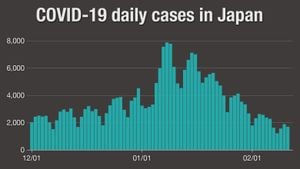Researchers have uncovered new insights about osteoclast differentiation, identifying p15Ink4b as a pivotal regulator of this process, with potential therapeutic applications for bone diseases like osteoporosis and rheumatoid arthritis.
Osteoclasts are specialized cells responsible for bone resorption, which is necessary for maintaining healthy bone remodeling. Dysregulation of osteoclastogenesis can lead to pathological bone loss, highlighting the significance of exploring the mechanisms behind osteoclast differentiation. Recent findings suggest p15Ink4b, a member of the Ink4 family of cyclin-dependent kinase (CDK) inhibitors, plays a novel role as an important regulator of osteoclasts.
This study, published by researchers at Yamaguchi University, stemmed from comprehensive single-cell RNA sequencing (scRNA-seq) analyses. By reanalyzing existing data, the research team focused on how p15Ink4b expression evolves during the differentiation process. Notably, they observed enhanced expression of p15Ink4b during late osteoclast differentiation, directly linking it to the regulation of key factors involved in osteoclast function.
The need for therapies targeting osteoclastogenesis stems from its relevance to various skeletal diseases. Osteoporosis and rheumatoid arthritis are just two examples where the disruption of normal osteoclast activity can result in serious health consequences. Understanding the mechanisms of osteoclast differentiation could pave the way for innovative approaches to manage these conditions.
Using scRNA-seq technology, the researchers were able to capture the cellular dynamics of osteoclast differentiation at different stages upon stimulation with Receptor Activator of Nuclear Factor kappa-Β Ligand (RANKL). Their analysis revealed distinct clusters of cells, showcasing those committed to the osteoclast lineage and demonstrating the progressive expression of molecules associated with osteoclast markers.
Subsequently, the research team performed validation studies, utilizing both histological analysis and established in vitro differentiation assays to examine p15Ink4b's role functionally. Their findings indicated cells expressing p15Ink4b also demonstrated increased osteoclast characteristics, including TRAP-positive multinucleated cell formation, confirming its regulatory effects.
Another significant aspect of the research was the examination of p15Ink4b function through targeted silencing. By employing siRNA techniques to knock down p15Ink4b expression, researchers observed marked suppression of osteoclast formation, enhancing the evidence for its supportive role during the differentiation process. This supportive evidence is underscored by the concurrent decrease of osteoclast-related gene expression following p15Ink4b knockdown, indicating comprehensive regulation.
The findings of this study, particularly the identification of p15Ink4b, not only expand current knowledge surrounding osteoclast biology but also open new avenues for therapeutic strategies targeting bone health. Clinical applications could arise from manipulating p15Ink4b levels to relieve excessive osteoclast activity, acting as a potential treatment for bone resorption-related diseases.
The research team draws additional conclusions about the need for follow-up studies to investigate the interactions of p15Ink4b with other known regulators of osteoclastogenesis, as well as exploring its roles across various cell types within the bone tissue. The complex nature of bone biology means more work is needed to understand the broader regulatory networks at play.
Overall, the discovery of p15Ink4b as a newly recognized regulator of osteoclast differentiation is promising. Their findings contribute not only to our basic scientific knowledge but potentially to the development of therapeutic interventions for skeletal diseases, fostering hope for advancements in treating conditions characterized by detrimental bone loss.



